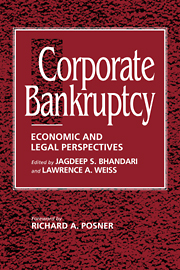Book contents
- Frontmatter
- Contents
- List of tables and figures
- Foreword by the HONORABLE RICHARD A. POSNER
- Preface
- Part I The role of credit
- Part II Bankruptcy as a reflection of the creditors' implicit bargain
- Part III Beyond the basic creditors' bargain
- Part IV Workouts or bargaining in the shadow of bankruptcy
- Part V Alternatives to bankruptcy and the creditors' bargain
- Part VI Experience of other countries
- Index
Part IV - Workouts or bargaining in the shadow of bankruptcy
Published online by Cambridge University Press: 10 December 2009
- Frontmatter
- Contents
- List of tables and figures
- Foreword by the HONORABLE RICHARD A. POSNER
- Preface
- Part I The role of credit
- Part II Bankruptcy as a reflection of the creditors' implicit bargain
- Part III Beyond the basic creditors' bargain
- Part IV Workouts or bargaining in the shadow of bankruptcy
- Part V Alternatives to bankruptcy and the creditors' bargain
- Part VI Experience of other countries
- Index
Summary
Although bankruptcy law is apparently designed to address the problems of creditors too dispersed to negotiate effectively for disposition of an insolvent firm's assets, settlement impediments can exist even if all important creditors can get together and negotiate face to face. Even with a limited number of creditors, one or more creditors may behave strategically, threatening to exercise destructive individual collection rights unless other creditors make concessions. The two chapters in the part, Stuart Gilson, “Managing Defaults: Some Evidence on How Firms Choose Between Workouts and Bankruptcy,” and John McConnell and Henri Servaes, “The Economics of Prepackaged Bankruptcy,” explain how creditors can use the bankruptcy process to impose a negotiated settlement on potential holdouts. Such use of the bankruptcy process would be expedited as compared to the imbroglios described by previous selection in the book.
Moreover, as Gilson and McConnell and Servaes illustrate, workouts, whether or not enforced by a “prepackaged” bankruptcy case, will reflect bankruptcy law entitlements, but need not lead to all the inefficiencies described by prior chapters.
- Type
- Chapter
- Information
- Corporate BankruptcyEconomic and Legal Perspectives, pp. 307Publisher: Cambridge University PressPrint publication year: 1996



